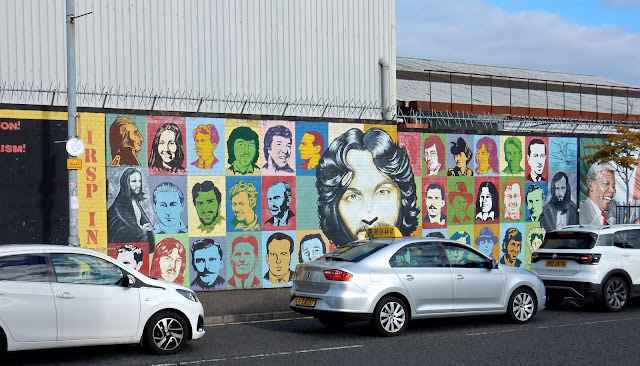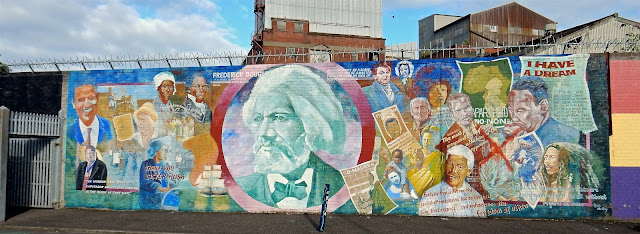The impressive Titanic Museum reminds the world this was a leading ship building city, the apex of an industrial power. Linen, tobacco, and rope making started a march to industrialization that now involves aerospace, missiles, and filmmaking.
The history is told masterfully in the marvel that tells the story of the building of the Titanic and its fate.
The Titanic and the HBO super hit Game of Thrones are a minor industry unto themselves in Belfast. Thrones was filmed across Northern Ireland and the studio is near the Titanic Museum and Hotel.
The room where the blue prints of the Tiatic were drawn is now a restaurant and bar with extraordinary natural lighting.
Belfast remains a city of culture and industry even though the famous and employment providing Harland and Wolff shipyard is facing uncertainty.
Belfast has a population between 300 and 400 thousand though it has the vibe of a larger city.
The source of the major Belfast storyline dates to the 1922 partition of Ireland. Belfast is part of the UK in Northern Ireland. That it and the Irish Republic adjoin is the nexus for what has been a history of Trouble.
The Parliament of Northern Ireland meets at Stormont in Belfast, though it has not met since 2017 and is presently in suspension because of the inability to agree. It is a symbolic image of the division that rends Northern Ireland.
Principally, because of what is euphemistically called "The Troubles," Belfast remains divided.
There are walls and cages for separation and protection in areas where Catholics and Protestants adjoin, or in neighborhoods where those who favor British rule and those who want to be independent or part of the Irish Republic reside closely.
There are walls and cages for separation and protection in areas where Catholics and Protestants adjoin, or in neighborhoods where those who favor British rule and those who want to be independent or part of the Irish Republic reside closely.
Violence from the Troubles once gave Belfast the reputation as one of the most dangerous cities in the world.
It is better now, but bitterness and hostility lurk.For years politics, emotion and legacy tributes have been painted on walls. They are an index to the struggles, memories of those who perished, either by hunger strike or by violence.
Belfast is a city of martyrs on walls.
The walls provide a narrative.
To get a feel for these areas, we hired a Black Taxi tour. 50 years ago former political prisoners began driving the taxis. It was a way to both earn a living and to proclaim by visiting friction spots, or places where freedom fighters died or places of military action.
On this day in Belfast we hired one of the original drivers, now an old boy, a former prisoner, and with a keen sense of these neighborhoods.
I thought it oddly ironic his aged cab needed a pause for repair at the very Clonard Abbey where the Good Friday Peace Agreement was achieved. (By the way he knew exactly what to do and where to pound.)
The phrase The Troubles is an anemic expression of what happened to Belfast and Northern Ireland. It was cultural and political war and a fight for self determination that cast shadows even now.
Divis Tower in the Falls neighborhood remains locked in that history. The British Army set up tower surveillance and sniper positions here.
Today the children of a woman who "disappeared" from here in 1972 wonder what happened to her. She was then a young widow with 10 children when taken. Her murder is still a matter of inquiry and investigation. It is featured in the non-fiction Say Nothing-A True Story of Murder and Memory in Northern Ireland written by Patrick Radden Keefe and published this year.
Throughout Belfast are memorials to those who perished in the Troubles.
The fallen of both sides are remembered, daily.
Sinn Fein remains in place and active and too has suffered loss.
It was in the room behind the fourth window on the ground floor where the Good Friday Agreement was reached on April 10 1998. It ended 30 years of active violence, military presence, bombing, riots and discord. It birthed an uneasy truce and with a long history as preamble.
The Women's Voices Matter movement is an island of words of hope and inspiration.
And the "Peace Wall" stands. While it is an open expression of peace, it is none-the-less still a wall between neighborhoods, like those barriers above the roofs.
Thousands from around the globe have been here to sign on for peace.
It is a history all should know. It is readily available.
Between 80 and 90 thousand cars pass the Sculpture RISE that went up in 2011.
Today as you drive from Ireland into Northern Ireland the road signs change from kilometers to miles and the words change from Gaelic and English to only English. License plates are different and that is how you know you are at or through the soft border. Brexit however, as ill conceived and foolish as it is, and as mishandled as it has been, threatens perhaps to raise up old animosities, stir ghosts, reanimate divide and hostility.
Good Friday has produced a kind of cooling and a reach for normalcy, but trouble has not disappeared.
It is indeed very complicated.
On the agenda, the lively, vivacious and friendly city of Dublin.
See you down the trail.























































Hello Tom:
ReplyDeleteI found your blog via my reading of Geo’s three blogs. I am very appreciative of the various images you have posted about Belfast. They and your explanations have helped me to better understand the current state of affairs there. I winder how Brexit shall further impact the city’s emotions when it eventually happens?
Even though your photos do depict aspects of strife, I must also state that many of the murals etc also exude a beauty and grace in their imagery.
Thank you!
PipeTobacco
Good of you to visit this space. Geo's blogs are among my favorites. I'm glad your visit there, sent you here.
DeleteA high percentage of Irish product , from the Republic, is bound for the UK. Almost all of the Irish product, that bound for Europe and elsewhere, must transit UK ports and engage UK transfer. So the Brexit "solution" could add cost and time at the very least.
It remains to be "worked out." I hope for the best.
And indeed, the public art is beautiful as well as poignant.
I often think.... wouldn’t it be nice if Britain were to figure out a way to make it acceptable to recite on the Brexit proposal? I suspect if they could find a way to make such a vote feel legitimate for everyone..... the vote would then likely be to stay in the EU.
DeleteAnd seriously, I would not be surprised if there were some sort of mischief afoot in that vote, like there was in the 2016 US election.
PipeTobacco
Oops.... “recite” was meant to be revote.
ReplyDelete